Results 3,271 to 3,280 of 12096
Thread: Anandtech News
-
09-04-13, 01:00 PM #3271
Anandtech: Qualcomm Announces its Smartwatch Platform - Qualcomm Toq
We’re at Qualcomm’s Uplinq 2013 conference where Qualcomm’s CEO Paul Jacobs has announced Qualcomm Toq, a smartwatch with a Mirasol color screen that can still be viewed outdoors in bright sunlight with touch capabilities, and wireless charging capabilities through WiPower LE.
The Toq shows notifications and looks like it has a few applications of its own, can control music playback and play locally to wireless headsets, and looks like it can do things like screening calls and show a variety of different watchfaces. Qualcomm is trying to leverage its mobile silicon leadership, Mirasol display, and enable partners to deliver better wearable products. The Mirasol display stays on all the time, never turns off, but still lets the Toq last multiple days between charges.
Later this month Qualcomm will make a limited number of Toqs available and continue to release more details about availability. There still are a lot of unknowns but we're hopefully going to find a lot more about Toq shortly.
More...
-
09-04-13, 02:00 PM #3272
Anandtech: ASUS Announces Transformer Book T300 – a Windows 8 Detachable Tablet
Earlier today (sorry – I’m writing these up as fast as my fingers will go!), ASUS announced their new Transformer Book Trio, a hybrid Android + Windows 8 tablet/laptop. We’re busy covering a bunch of their IFA announcements, but some of the first comments on the Trio are, “Why can’t ASUS just give us a Windows 8 tablet and forget Android?” The Transformer Book T300 does exactly that, though you can expect battery life to take a hit relative to the Android mode of the Trio, and the screen is a somewhat large for a tablet 13.3”.
The good news is that other than size, you get a rather potent tablet/hybrid computer. The CPU options consist of the i3-4010U (1.7GHz), i5-4200U (1.6-2.6GHz), and the i7-4500U (1.8-3.0GHz), with Intel’s HD Graphics 4400 handling graphics duties. Even better, the display is a 13.3” 1080p IPS panel with 10-point capacitive multitouch. ASUS also notes that their display senses a 6mm contact point instead of 9mm, providing greater precision. Memory is listed as “up to 8GB”, which likely means there will be a low-end Core i3 model with 4GB and the higher end models will come with 8GB soldered onboard. Storage is pure SSD, using the NGFF/M.2 standard and supporting 64/128/256GB options.
Other features include a rear 1080p camera and front 720p camera – and I can’t wait to see someone trying to record video or take pictures with a 13.3” tablet! (Seriously, other than children, does anyone use the rear-facing camera on their 10” and larger tablets? I know I don’t.) Connectivity consists of 802.11n (ASUS doesn’t mention whether it’s dual-band or not, so I’m guessing not), USB 3.0, micro-HDMI 1.4, microSD, and 3.5mm headphone/mic. The dock adds an additional micro-USB 3.0 port.
Interestingly, it appears the T300 dock does not include any additional battery capacity. ASUS rates the battery life at up to 8 hours with the included 6710 mAh lithium polymer battery, but there’s no comment on additional battery life when docked, which is a shame. The dock does include backlit keys and a large multitouch touchpad, however, with full size keys. The tablet half of the T300 measures 342mm x 216mm x 11.5mm and weighs 1.1kg, and the keyboard dock measures 340mm x 216mm x 11mm and adds 800g. Combined, you get something that’s nearly an Ultrabook, with the option to detach and take the tablet with you as you see fit.
As is the case with all the other ASUS announcements today, pricing and availability have not been finalized, but I expect we’ll see all of these new devices in time for the holidays. I’d also expect something like the T300 with Core i5 and a 128GB SSD to come in closer to the $1000 price point, though I’d love to be surprised and see it below $800, as that’s where it becomes truly able to displace high-end Android and iOS devices.
More...
-
09-04-13, 02:00 PM #3273
Anandtech: ASUS Announces MeMO Pad 8 and MeMO Pad 10 Tablets
Joining the slew of IFA announcements as well as the MeMO Pad HD7, ASUS has two more MeMO Pad tablets on the way: the MeMO Pad 8 (ME180A) and MeMO Pad 10 (ME102A). Some of the details are a bit light right now, as all we know for certain is ASUS will be using quad-core 1.6GHz SoCs, but considering the MeMO Pad HD7 uses a quad-core MediaTek MT8125 (4 x Cortex-A7), that would seem the likely SoC of choice for the new MeMO Pads as well. ASUS seems to be using the MeMO lineup to introduce budget-friendly offerings, and while they haven’t disclosed pricing on the new models I suspect they’ll be well into the sub-$200 range like the HD7.
The specifications for the two tablets are quite similar in most areas, other than size. Both have 1280x800 IPS displays with 10-point capacitive multitouch, with the MeMO Pad 8 using an 8” display and the MeMO Pad 10 using a 10.1” display. They both include 1GB RAM, but the ME180A is only available with 16GB onboard storage while the ME102A is available with either 8GB or 16GB – though microSDXC slots are allow users to easily add more storage. Cameras are another area where the two differ: the 8” model has 5MP rear/1.2MP front (720p HD recording on the rear is supported) while the 10” has a 2MP rear/1.2MP front (again with 720p recording available from the rear camera). 802.11n WiFi and Bluetooth 3.0 are present, along with micro-USB and a 3.5mm headphone/mic jack. The MeMO Pad 8 has an accelerometer, e-compass, and proximity (I admit I’m not sure what that last means); the 10 has A-GPS with GLONASS instead and drops “proximity”.
In terms of battery life, the 10 has a 5070 mAh battery while the 8 has a 3950 mAh battery, but the larger display apparently uses most of the extra capacity. The 10 is rated for up to 9.5 hours of 720p video playback and the 8 is rated at 9 hours. The MeMO Pad 8 measures 212.4mm x 127.4mm x 9.95mm and weighs 350g while the MeMO Pad 10 is 256mm x 174.6mm x 10.5mm and weighs 522g. Both models are available in white, grey, or pink, with pricing and availability not yet finalized. (I’m getting really tired of saying that….)
More...
-
09-04-13, 03:30 PM #3274
Anandtech: ASUS Announces X102BA Touchscreen Ultraportable with AMD’s Temash APU
As we wrap up with ASUS’ IFA announcements for today, we shift from the tablet and smartphone sectors over to laptops. Launched back in May, Kabini is AMD’s alternative to Intel’s Atom; Temash is the lower power variant, with basically the same hardware but reduced clock speeds. Since May, we haven’t heard too much about Temash – there are a few (one?) laptops out using the SoC/APU, like the HP TouchSmart 11, but that’s about it.
ASUS is going to double the number of Temash laptops in the wild with their upcoming X102BA ultraportable, otherwise known as a 10.1” touchscreen netbook. This is definitely going to be a device for the budget minded, and while ASUS hasn’t released pricing information yet I suspect (hope) we’re looking at starting prices around $300, though the inclusion of Windows 8 and Office 2013 may push prices closer to $400+.
In terms of the hardware, the X102BA comes with an A4-1200 APU, a dual-core Jaguar chip running at 1GHz with Radeon HD 8180 graphics. Neither one of those are going to set the performance world on fire, but the targeted power of the A4-1200 is 3.9W so battery life should be decent. ASUS rates the 33Wh battery at up to 5 hours of battery life with 720p HD video playback, and presumably it would do better under lighter loads like surfing the Internet or just typing.
The X102BA comes with either 2GB or 4GB DDR3 memory, 320GB/500GB HDD, 802.11n WiFi (2.4GHz most likely), Bluetooth 4.0, a single USB 3.0 port, and VGA and HDMI video ports. The display is a 1366x768 panel, most likely TN, with 10-point input and a 5mm contact point for enhanced precision. Also included is an SD card slot and a 720p webcam. ASUS provides a full copy of Microsoft Office Home and Student 2013 (Word, Excel, PowerPoint, OneNote), making this potentially a handy and inexpensive companion for students.
The ASUS X102BA will be available later this year in several colors: white, black, hot pink, and ocean blue. Dimensions for the X102BA are similar to the old 10” netbooks of yesteryear: 266mm x 185mm x 23.3~29mm with a weight of 1.1kg (2.42 lbs).
More...
-
09-04-13, 04:30 PM #3275
Anandtech: ASUS Announces Zenbook UX301 and UX302 Haswell Ultrabooks
Our final ASUS IFA announcement for today is for their new Ultrabooks, which we’ve been waiting to see for a couple months now. I thought ASUS pretty much nailed it with their Ivy Bridge UX31A, with a good balance of style, battery life, and high-end features. The UX301 and UX302 look to take the core elements of the UX31A/UX32VD, the former of which earned an Editors’ Choice from us, and upgrade them the Haswell while tossing in some even better hardware and displays. Better than the 1080p IPS panel in the UX31A? It appears so (at least on some models).
The base display for either laptop is a 13.3” 1080p IPS touchscreen, so there’s no longer a 1366x768 “cheap” model muddying the waters. The UX301 takes things a step further and offers an upgrade to a 2560x1440 (WQHD) IPS panel, which should delight our readers that long for higher dpi displays. Of course, the display isn’t the only area to receive an upgrade.
At the core of the new Ultrabooks beats Intel’s Haswell heart, with some interesting twists. The UX301 is available with an i5-4200U or i7-4500U, which is standard fare, along with a third option: the i7-4558U. This is the famous 28W TDP Haswell chip that has a GT3 (40 EU) core, with the Iris Graphics 5100 providing performance that should be substantially higher than the GT2 15W Haswell SKUs. The UX302 skips the 28W Haswell CPU but instead includes a GeForce GT 730M 2GB dGPU to handle graphics duties. The GT 730M is basically the same as the GT 650M but with slightly lower clocks, so we can get at least some idea of the performance potential by looking at the ASUS UX51VZ; don’t expect the ability to max out graphics at playable frame rates, but medium to high detail at 1080p should be possible in many titles.
Moving on to the other areas, we get a few somewhat odd decisions. I’m guessing the RAM will be soldered onto the motherboard again, and the UX301 comes with either 4GB or 8GB while the UX302 will only be available in a 4GB form (possibly via an upgradable SO-DIMM). Storage on the UX301 will be pure SSD, up to 512GB RAID 0; on the UX302, we’ll get up to a 750GB HDD with a 16GB SSD cache. WiFi for both laptops is 802.11ac with Bluetooth 4.0, with two USB 3.0 ports on the UX301 and three USB 3.0 ports on the UX302. Both models also include mini-DisplayPort and micro-HDMI 1.4, with an SD card reader and 3.5mm headphone/mic jack. Interestingly, ASUS doesn’t mention battery life, but the 50Wh battery combined with Haswell should prove suitable to all-day (light) computing.
The UX301 measures 325mm x 226mm x 15.5mm and weighs 1.38kg (3.04 lbs) while the UX302 measures 325mm x 226mm x 17.2mm and weighs 1.5kg (3.3 lbs). The slightly thicker chassis and increased weight on the UX302 are the result of including a conventional hard drive, which is probably a good idea for users that want to play games on the system. ASUS doesn’t mention the form factor of the SSD or SSD cache, so I’m guessing the UX301 will use the same proprietary connector as the current UX31A while the SSD cache on the UX302 is likely to be soldered onto the motherboard. However, the use of a standard 2.5” HDD in the UX302 means upgrading to a pure SSD solution is easy enough to do, provided you’re willing to buy the hardware.
Besides all of the core components, ASUS did make some changes in the industrial design this round. The UX301 and UX302 have the same metallic “spun” metal on the cover, a trademark of the Zenbook line, but there’s now a layer of Corning Gorilla Glass 3 on top to provide increased resistance to scratching and other wear and tear. ASUS notes that “Gorilla Glass 3 has three times the scratch resistance of Gorilla Glass 2 and offers a 40% reduction in the number of highly visible scratches, with a 40% improvement in retained strength if a deep scratch does occur”, though I’m not sure how the high-gloss finish will handle fingerprints. Nevertheless, the new Ultrabooks look quite nice, and the “Moonstone White” and “Sapphire Blue” colors are a nice break from the black and silver that I’ve frankly seen too much of in recent years.
The new ASUS Ultrabooks should be shipping sometime in the next month or two, though pricing and availability are not yet finalized. I’m personally looking forward to both models, preferably with the i7-4558U in the UX301 with the WQHD display, but the UX302 is definitely worth a look as well. They’ll probably be in the $1000+ price range again, with fully loaded configurations hitting $1500 or more, but quality has a price.
More...
-
09-04-13, 10:00 PM #3276
Anandtech: Samsung Introduces Galaxy Note 10.1 (2014 Edition) with 2560x1600 Display
Alongside the Galaxy Note 3, Samsung also updated its 10.1-inch Galaxy Note with a 2014 Edition of the tablet. The changes to the 10.1-inch Galaxy Note mirror those of the Galaxy Note 3. The industrial design gets an update to include a faux leather back cover with stitching and textured rim. The combination of the two, once again, is a nice deperature from the slippery plastic of previous Galaxy tablets but still lacks the premium feel of metal. Unlike the Note 3, the 2014 Galaxy Note 10.1 is only available in jet black or classic white.
Internally we see many of the same changes that impacted the Galaxy Note 3. LTE versions of the tablet will feature a 2.3GHz Qualcomm Snapdragon 800 SoC, while 3G and WiFi versions of the tablet will ship with Samsung's own Exynos 5420.
The display moves to a 2560 x 1600 "Super Clear" LCD. Storage options range from 16GB to 64GB, and all variants come with a microSD card slot.
The 2014 Galaxy Note 10.1 will ship in Q3 with Android 4.3 and Samsung's KNOX.
Gallery: Samsung Galaxy Note 10.1 (2014 Edition)





More...
-
09-04-13, 10:00 PM #3277
Anandtech: Samsung's Galaxy Note 3: Snapdragon 800 in a Slimmer Galaxy Note
Samsung was among the first to discover the demand for very large smartphones and quickly addressed that market with its Galaxy Note lineup. The smartphone Notes combine a large display (greater than 5-inches) with an active digitizer (S Pen). Last year Samsung expanded the Note family to include 8 and 10-inch tablets as well as smartphones. Blurring lines even further are the cellular variants of Galaxy Note tablets, some of which can function as full fledged smartphones in that they can make and receive phonecalls. Earlier today Samsung announced the third generation of its successful Galaxy Note smartphone device, the aptly named Galaxy Note 3.
The Note 3 continues Samsung's recent habit of making its devices thinner and lighter while increasing screen size. The Note 3 increases its screen size by 0.18" diagonally compared to the Note 2 (the 5.7-inch display actually measures 144.3mm or 5.68"). Despite the larger display, nearly all dimensions of the Note 3 shrink compared to its predecessor. The Note 3 is slightly taller (+0.1mm) but is less than a millimeter narrower and nearly a full millimeter thinner. The Note 3 also drops in weight by 12 grams. The result is an even bigger display in a smaller, more usable device.
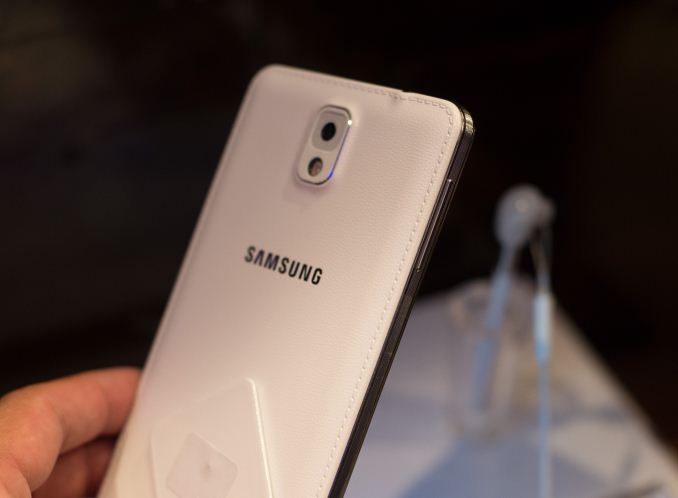
Responding in part to criticism of Samsung's use of cheap feeling plastics in thier phones, the Galaxy Note 3 adds a bit of texture into the mix. The back of the device is covered in a soft touch faux leather, complete with stitching. The plastic trim around the device also gains a texture, apparently designed to mimic pages of a notebook:
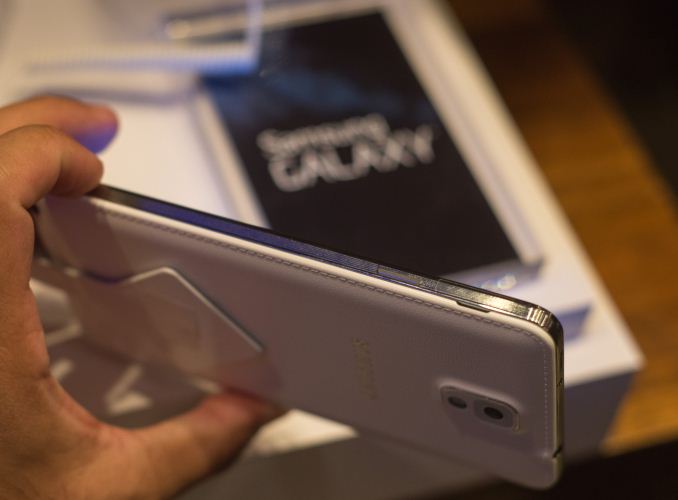
The combination of the two definitely help make the Note 3 feel less of a slippery mess, but those hoping for a truly premium feel will probably continue to be disappointed. The Galaxy Note 3 will be available in classic white, jet black and blush pink at launch. The back cover is removable, hiding a slightly larger 12.16Wh (3.8V) removable battery. Samsung offers other back covers in 9 other colors if you want some additional personalization.
Internally the Galaxy Note 3 becomes a far more modern platform. LTE versions of the Galaxy Note 3 will feature a 2.3GHz Qualcomm Snapdragon 800 SoC, while 3G versions will use Samsung's updated Exynos 5 Octa (5420). The Exynos 5420 features four ARM Cortex A15s running at up to 1.9GHz and four Cortex A7s running at up to 1.3GHz. The updated design should hopefully feature a fully cache coherent interface between both processor islands, something that wasn't functional in the first Exynos 5 Octa SoC.
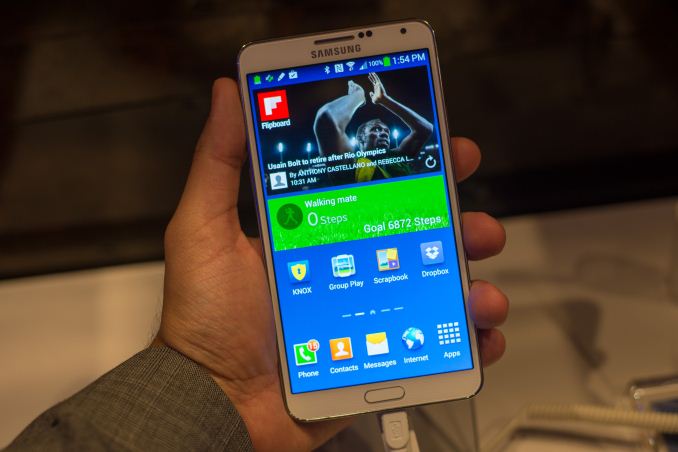
The rear facing camera gets a bump up to 13MP, while the front facing sensor moves to 2MP. Samsung is likely using the same sensors it uses in the Galaxy S 4 in the new Note 3. The on-board memory also sees an increase to 3GB. Finally, like the Galaxy S 4, the Galaxy Note 3 adds 802.11ac support.
A big part of the Galaxy Note story is the integrated S Pen active digitzer. Samsung redesigned the S Pen for the new Note and combined it with some new features:Galaxy Note Physical Comparison Samsung Galaxy Note (USA) Samsung Galaxy Note 2 Samsung Galaxy Note 3 Samsung Galaxy S 4 Height 146.8 mm 151.1 mm 151.2 mm 136.6 mm Width 82.9 mm 80.5 mm 79.2 mm 69.9 mm Depth 9.7 mm 9.4 mm 8.3 mm 7.9 mm Weight 178 g 180 g 168 g 130 g CPU 1.5GHz APQ8060 (Dual Core Scorpion) 1.6GHz Samsung Exynos 4412 (Quad Core Cortex A9) LTE: 2.3GHz MSM8974 Snapdragon 800 or 3G: 1.9GHz Exynos 5420 1.9GHz Snapdragon 600 or 3G: 1.6GHz Exynos 5410 GPU Adreno 220 Mali-400MP4 Adreno 330 or Mali-T628 MP6 Adreno 320 or PowerVR SGX 544MP3 RAM 1 GB LPDDR2 2 GB LPDDR2 3 GB 2 GB LPDDR2 NAND 16 GB NAND with up to 32 GB microSD 16/32/64 GB NAND (?) with up to 64 GB microSD 32/64 GB NAND with up to 64 GB microSD 16/32 GB NAND with up to 64 GB microSD Camera 8 MP with LED Flash + 2 MP front facing 8 MP with LED Flash + 1.9 MP front facing 13 MP with LED Flash + 2 MP front facing 13 MP with LED Flash + 2 MP front facing Screen 5.3" 1280 x 800 HD SAMOLED 5.5" 1280 x 720 HD SAMOLED 5.68" 1920 x 1080 HD SAMOLED 5.0" 1920 x 1080 HD SAMOLED Battery Removable 9.25 Whr Removable 11.78 Whr Removable 12.16 Whr Removable 9.88 Whr
Action Memo allows users to handwrite a note, and automatically execute a function or convert that handwritten information into formatted content. Action Memo can instantly initiate a call, add to contacts, look up an address on a map, search the web, save a task to a to-do list, and moreOther traditional Touchwiz features see enhancements with the Note 3 as well. Samsung has supported multi-window applications for a while now, but with the Note 3 you can now actually open multiple windows of the same application (e.g. two browser windows displaying different things). Samsung also added a new group play mode that lets you wirelessly connect up to five devices and play video across all of the devices acting as a single large display.
Scrapbook enables users to organize or track down content and information from various sources including the web, YouTube and Gallery in one place so that users can easily look back at collected content all at once. When consumers save content for future use, Scrapbook also collects source material or URLs allowing them to easily refer back to the original source.
The Screen Write feature captures the full screen image of the current page on the device and allows users to write comments or additional information onto the captured image.
S Finder allows users to expansively search for content on their device regardless of the type. By putting in keywords or filters such as date, location, and content type, users can search related documents, events, communication threads, and even the Help page – all in one place. In addition, users can also search for hand-written content in their Notes and memo applications, as well as symbols and formulas.
Pen Window allows users to use the S Pen not only for drawing sketches or writing notes, but now also for opening a small application window for a true multitasking experience. Simply by drawing a window of any size, anywhere on the screen, users can easily and quickly open another application window such as YouTube, calculator or Browser without pausing current activity on the screen.
The Galaxy Note 3 ships with Android 4.3 and KNOX. Devices will be available starting on September 25th in 140 countries around the world. Availability on US carriers (AT&T, Sprint, T-Mobile, Verizon & US Cellular) will come later this year.
Gallery: Samsung Galaxy Note 3: Hands On





More...
-
09-05-13, 03:01 AM #3278
Anandtech: Xiaomi Announces the MI3 - Tegra 4 and MSM8974AB inside
Xiaomi has been making some interesting news lately, first with the abrupt transition of Hugo Barra from Google to Xiaomi, now with the announcement of their latest high end smartphone, the MI3, at their New Product Convention 2013 event. What was interesting about the MI2 announcement last year was that it was one of the first to include Qualcomm's quad core APQ8064 SoC inside, and Xiaomi has included Qualcomm SoCs since the MI1 (MSM8660). I still remember my first experiences with the Xiaomi MI1 and the value prospect that the device made me realize existed with the right set of conditions, and how impressed I was with that hardware. With the MI3 Xiaomi goes to variants based on both Snapdragon 800 (MSM8974AB) and NVIDIA's Tegra 4 platform.
The WCDMA (China Unicom) and CDMA2000 (China Telecom) variants of the MI3 come based on Qualcomm's Snapdragon 800 MSM8974AB platform, while the TD-SCDMA (China Mobile) variant is based on NVIDIA's Tegra 4 platform.
Xiaomi makes the first (to my knowledge) public disclosure of MSM8974AB, which is analogous to the changes we saw between APQ8064 and APQ8064AB. From 8974 to 8974AB, Adreno 330 GPU clocks climb from 450 MHz to 550 MHz, LPDDR3 memory interface maximum data rates go from 800 MHz to 933 MHz, and the ISP clock domain (I think Xiaomi might mean the Hexagon DSP here) goes from 320 MHz to 465 MHz. 8974 comes in both a bin with the 4 Krait 400 CPUs clocked at 2.2 GHz (really 2.15 GHz) and 2.3 GHz (2.26 GHz) with slightly different pricing, while 8974AB comes with a Krait 400 clock available only at 2.3 GHz. Process is still TSMC 28nm HPM, but I suspect that the AB variant might have the high k dielectric and/or transistor mix tuned slightly differently based on a few rumblings I've heard recently.
It's safe to say that Tegra 4 hasn't been the overwhelming success that NVIDIA had hoped for, nor able to continue the momentum that Tegra 3 built, so winning a slot with Xiaomi MI3 is a relatively big deal, even if Xiaomi's slice of the Chinese market isn't very large yet. The TD-SCDMA variant includes Tegra 4's 1.8 GHz ARM Cortex A15 4+1 architecture with 72 core GeForce GPU built on TSMC 28nm HPL. We've written a lot about Tegra 4, and got a chance to look at performance in the NVIDIA Shield review and came away impressed with performance in that platform. Of course the real interesting question is how Tegra 4 will perform in platform with smaller TDP and available platform power. Xiaomi claims relatively similar performance between Tegra 4 and 8974AB variants in a few system benchmarks as well. If we get the chance the MI3 might make for an interesting vehicle to compare the two SoCs in almost the same platform.
I'm not sure whether the MI3 uses the discrete Icera i500 modem for TD-SCDMA. i500 is fully TD-SCDMA enabled, so there's no reason that NVIDIA couldn't have won the entire platform slot, but I haven't confirmed it yet.
Either way Xiaomi is an increasingly interesting player in the Chinese market and always seems to make SoC choices that interest us.
Source: Xiaomi
Gallery: Xiaomi Announces the MI3 - Tegra 4 and MSM8974AB inside





More...
-
09-05-13, 12:00 PM #3279
Anandtech: Samsung's S9110 Watchphone: What Came Before the Galaxy Gear
Last night I got a reminder from my friend Vlad that my Galaxy Gear headline wasn't technically accurate - the Gear wasn't Samsung's first wearable. I responded saying that technically wearables were a new category, he responded telling me that technically my headline was a lie. He had a point.
"Today Samsung threw its hat in the wearables race with its announcement of the Galaxy Gear: a companion device designed to be worn like a watch."
Note while the Galaxy Gear is Samsung's first "wearable" by a modern definition of the term, this is definitely not the first connected watch that Samsung has released. Back in 1999 Samsung sold a watchphone under roughly the same conditions as the Galaxy gear. Borrowing from their announcement of the SPH-WP10:
"The SPH-WP10 is Samsung's first product developed as part of a market segmentation strategy designed to respond to the nearly saturated domestic market for wireless handsets. "
In other words, the phone market at the time looked mature and Samsung wanted to ride another growth wave. Sound familiar?
"As the smartphone and tablet markets shift from high growth to the early stages of maturity, forward looking companies are looking at other adjacent markets for continued growth."The Galaxy Gear's roots seem firmly planted in a design that came out a decade later though: the S9100 (pictured above on the left, the Gear is on the right). There are definite similarities in the industrial design between the S9100 and the Galaxy Gear, the latter looking like an evolved/more modern version. There are also physical differences:
The S9110 was larger, thicker and weighed mode - it also had a slightly larger, but lower resolution TFT display. Given the advances in display technology over the past four years, the differences here aren't unexpected at all.Samsung Galaxy Gear Evolution S9110 Galaxy Gear Release Year 2009 2013 Dimensions 41.1 x 57.5 x 11.98 mm 36.8 x 56.6 x 11.1 mm Weight 91 g 73.8 g Display 1.76" 176x220 TFT 1.63" 320 x 320 Super AMOLED Processor ? 800MHz single-core Cortex A9? Storage/RAM 40MB/? 4GB/512MB Battery 630 mAh @ ?V 315 mAh @ ?V
Samsung lists the S9110 as only having 40MB of internal storage, which I'm assuming refers to on-board NVRAM. There's nothing I could find that called out the silicon inside but it's safe to assume that it's something much slower than what ended up in the Galaxy Gear.
It's interesting to see the evolution of the S9110's design end up as the Galaxy Gear. It also feels like we're seeing a bit of a pattern here, with wearables showing up whenever phone markets appear to be saturating. I always assumed that this was the last major phone revolution, but I do wonder if there might be another phase after this one.
Gallery: Samsung's S9110 Watchphone: What Came Before the Galaxy Gear





More...
-
09-05-13, 01:00 PM #3280
Anandtech: Amazon Launches New Kindle Paperwhite
With all the advances in tablet technology, the experience of reading a physical book is still preferred by many people – or if not a book, then an e-book with electronic ink instead of an LCD or OLED display. Amazon has had a lot of success with their Kindle e-book readers over the years, and today they’ve announced the latest model, the Kindle Paperwhite. Scheduled to start shipping at the end of the month (September 30, 2013), the Paperwhite boasts an upgraded display, an enhanced backlight for reading in the dark, and faster processing to speed up page turns. All of the new features are certainly welcome updates, but the price is also substantially higher than the standard Kindle: $119 (with the current special offers) will get you the Kindle Paperwhite, while the previous Kindle is available for $69. There’s also a 3G Paperwhite available for $189, which adds free 3G connectivity with no contracts or monthly fees.
There are plenty of reasons for book lovers to prefer the Paperwhite over reading on a tablet. There’s no glare in bright sunlight, for one, and I personally find the reading experience to be more comfortable on the eyes. The Kindle is also lighter than similar size tablets, and battery life (with WiFi off) is listed as up to eight weeks between charges (depending on your usage, naturally). Battery life incidentally is also rated at twice that of the previous Kindle, though whether that’s thanks to improved technology or simply a larger battery I’m not sure (probably a little of both). Here’s the full set of specifications:
Amazon Kindle Paperwhite Specifications Display 6" Paperwhite
Exclusive Carta e-paper technology
Next-generation built-in light
212 ppi, 16-level gray scaleSize 6.7" x 4.6" x 0.36"
(169 mm x 117 mm x 9.1 mm)Weight 7.3 ounces (206 grams) System Requirements None; fully wireless and no computer required On-Device Storage 2 GB internal (~1.25 GB available)
Holds up to 1,100 booksCloud Storage Free cloud storage for all Amazon content Battery Life A single charge lasts up to eight weeks
(30 minutes of reading per day, wireless off and light setting at 10)
Battery life will vary based on light and wireless usageCharge Time Approximately 4 hours from a computer via USB cable Wi-Fi Connectivity 802.11n (WEP, WPA, WPA2 security)
Wi-Fi Protected Setup (WPS)
Optional 3G Wireless on Paperwhite 3GContent Formats Supported Kindle Format 8 (AZW3)
Kindle (AZW)
TXT
PDF
Unprotected MOBI
PRC natively
HTML
Word (DOC, DOCX)
JPEG, GIF, PNG, BMP (through conversion)Warranty and Service 1-year limited warranty included
Optional 2-year Extended Warranty available for U.S. customersIncluded in the Box Kindle Paperwhite, USB 2.0 charging cable and Quick Start Guide Price Kindle Paperwhite: $119 promotion, $139 normally
Kindle Paperwhite 3G: $189 promotion, $209 normally
More...
Thread Information
Users Browsing this Thread
There are currently 13 users browsing this thread. (0 members and 13 guests)




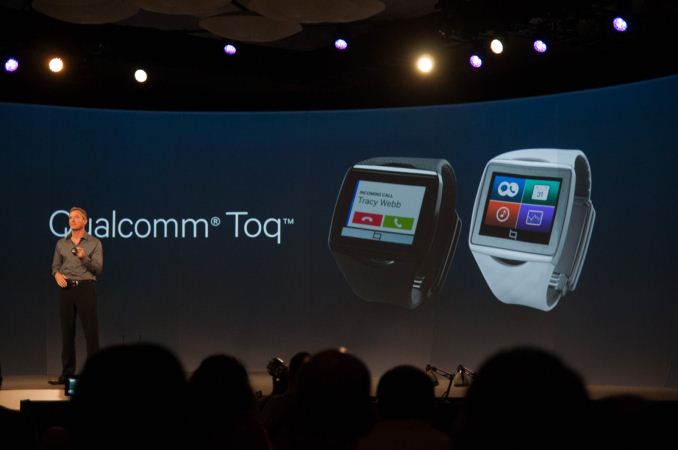


 Quote
Quote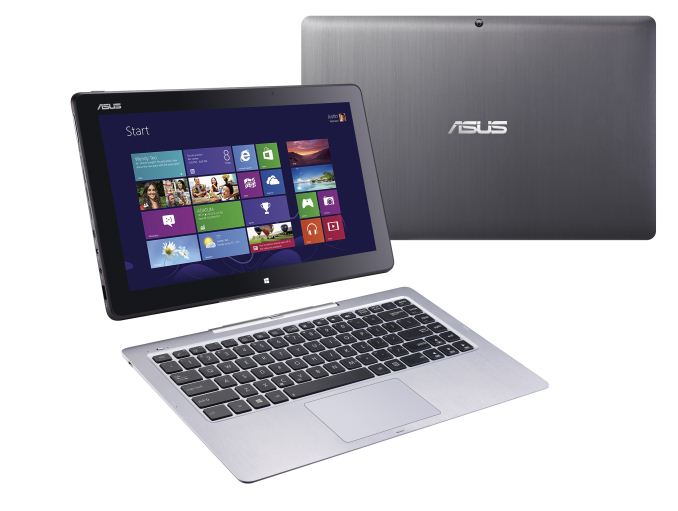


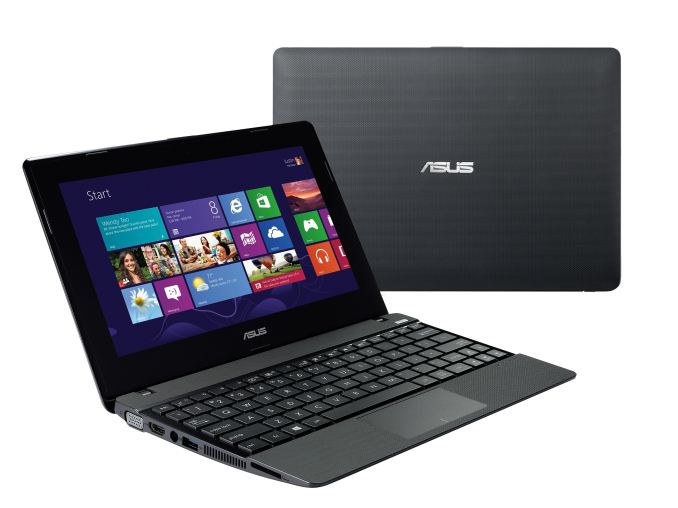
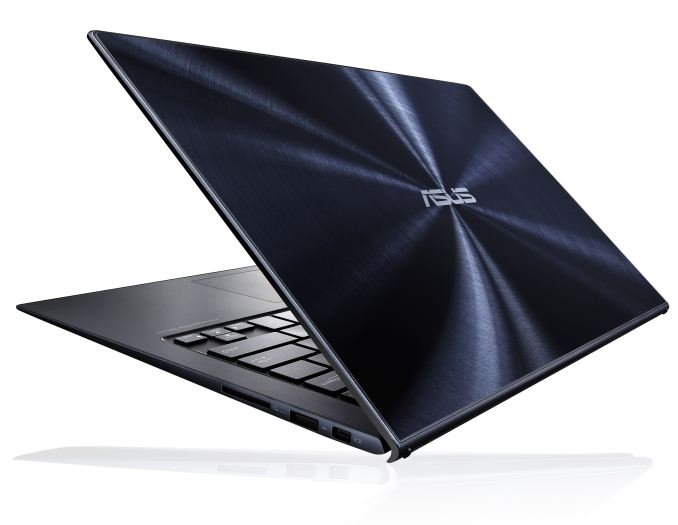

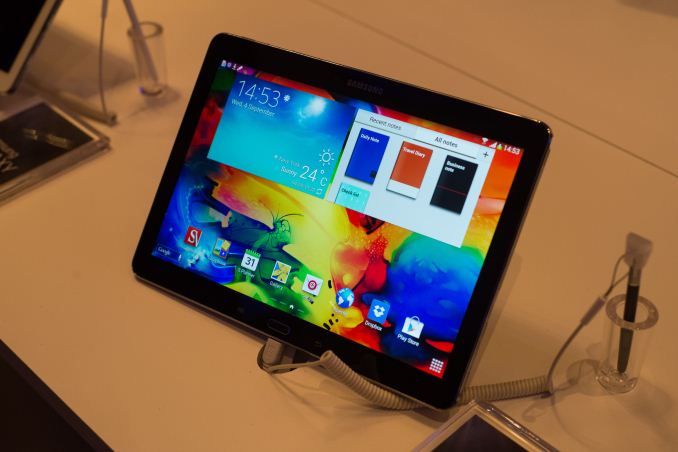
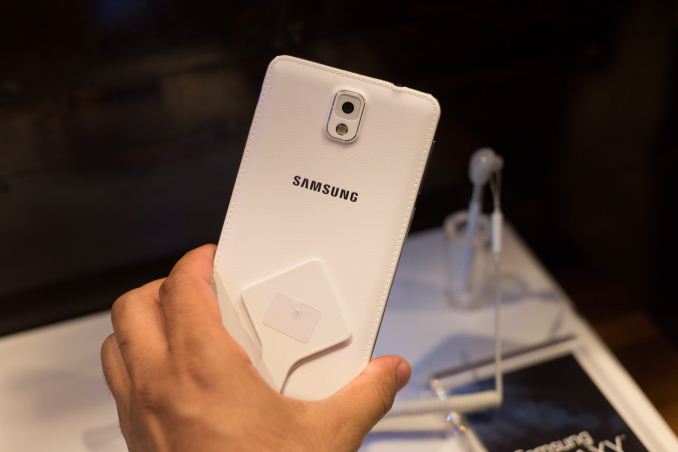
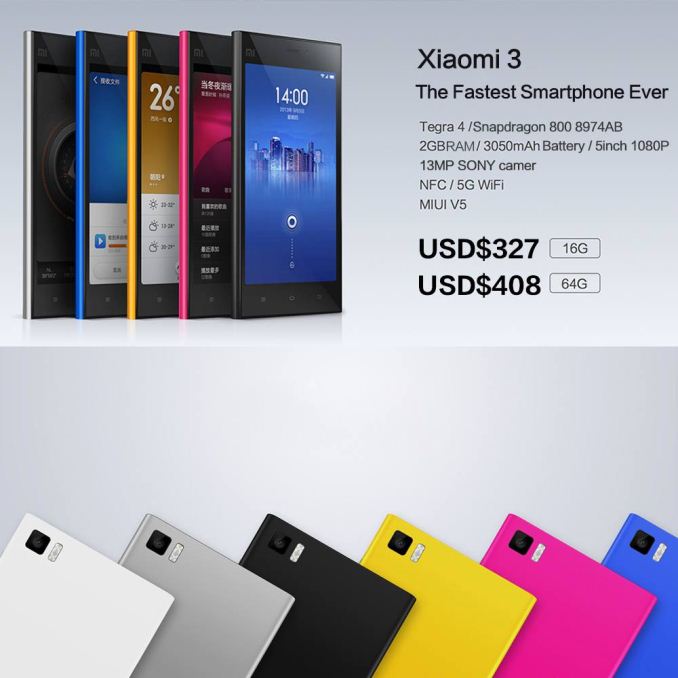

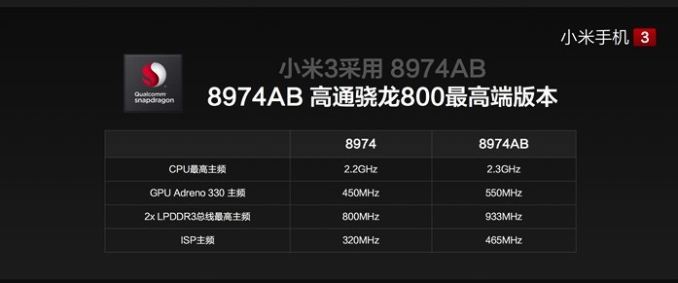
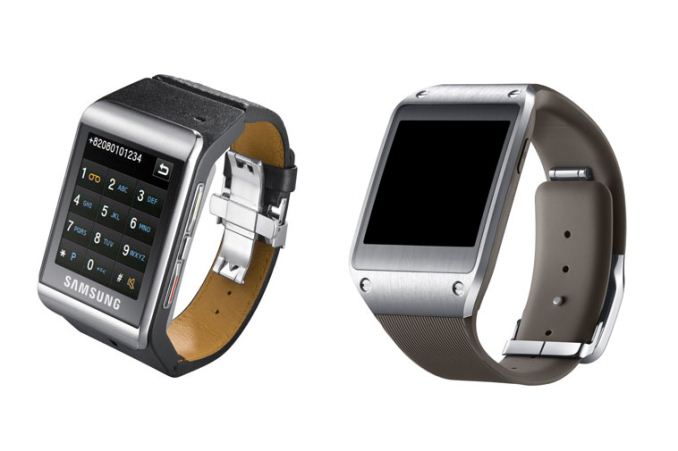
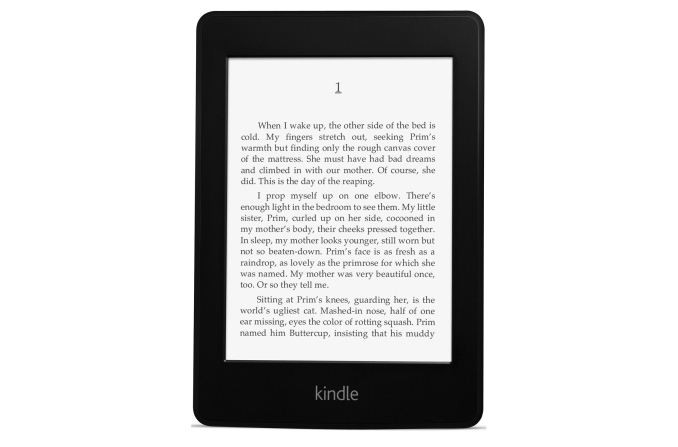

















Bookmarks